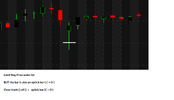Hello All ,
Using Amibroker AFL
If the stratagy opens a trade when the daily bar hits the limit buy order and closes the trade on the first up tick bar ( C > O )
sometimes the bar that creates the open of a trade is an up tick bar ( C > O ) .
And so takes on being both a buy signal and sell signal bar because it is an up tick bar ( C > ) )
Would it be possible using the AFL code to prevent this from happening .
All feedback , suggestions and comments would be very helpful
Thanks in advance
michael Bethell
Using Amibroker AFL
If the stratagy opens a trade when the daily bar hits the limit buy order and closes the trade on the first up tick bar ( C > O )
sometimes the bar that creates the open of a trade is an up tick bar ( C > O ) .
And so takes on being both a buy signal and sell signal bar because it is an up tick bar ( C > ) )
Would it be possible using the AFL code to prevent this from happening .
All feedback , suggestions and comments would be very helpful
Thanks in advance
michael Bethell


